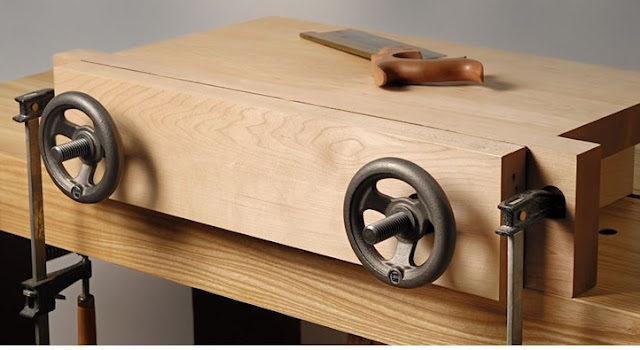So now comes the very long post regarding the leg construction on this bench. It is very critical that you get the offset leg angles correct or the stability will be compromised. I encourage you to e-mail me if I do not relay this information in a manor that can be easily digested. Now that the disclaimer is out of the way, lets do some math!
Let's start with a formula for the leg height. Take the top thickness and add 3 1/2 " for the top braces and the bottom skis. My top is 2 1/2 + 3 1/2 = 6". Now, take the total height you want your bench to be, mine will be 38" for my 5' 10" stature, and subtract the answer from the first math, 38 - 6 = 32".You will now need a piece of cardboard or plywood that is the depth of your top wide by the answer from our equation ( 24"w X 32"t) This is is what we will use to determine our leg angles and stock length.
Along the top of your board , it does not matter if you start from the left or right because it will be flipped over to do the other leg, just start from the opposite edge when you flip it over, make a mark the thickness of your apron ( mine is 3/4") From that mark measure the distance between the front apron and the tool tray apron (actual top glue up depth) and make another mark. Make a 1" mark off those marks toward the center.. The 1" space leaves room to fasten the legs to the top using lag bolts.


Confused yet? It get's worse! Now, from the mark 1" off of the tool tray apron (inside edge of leg) to the front bottom edge of the layout board( outside edge of leg ) I lay one of my leg blanks on those marks. my leg blanks ended up 4 1/2" wide, this is the front leg angle. I then lay my back leg blank directly on top of that one at the 1" off the front apron mark to the opposite bottom corner of my rectangular pattern board using a spacer on each end to hold it up.( DANGER WILL ROBINSON!!! It is critical that the thickness of your legs be the same or less than the piece of stock outboard of the saw slot/ plane stop, or your saw will not go into it!!!!) Trace where the back leg lands on the front leg and viola! leg angles!




I use a Festool TS 55 to cut as many kerfs as I can exactly half way through my front leg half lap as possible.Then it is a matter of popping the bulk of the material loose with a chisel and my THOR mallet. I then clean up the edges of the joint with a rabbit plane and then a bench plane for the center portion. Lay the blank back on the board in the same spot and put the back leg into the joint and transfer where the corresponding lap joint occurs and repeat the letting in procedure. Now put the joint together and lay the hopefully X shaped assembly on the layout board in the correct spot. The top and bottom edge of the board gives you the line to cut the legs to length!

This is where I am in the process, we will do the top braces and bottom skis next post. If you are building this bench I am dying to see your progress. So please, please send me photos and I will post hem here. "The Schwarz" looks in on the blog occasionally so if you want to show him what us nobodies can do........
 RSS Feed
RSS Feed Twitter
Twitter




 10:55 PM
10:55 PM
 Tim Williams
Tim Williams







